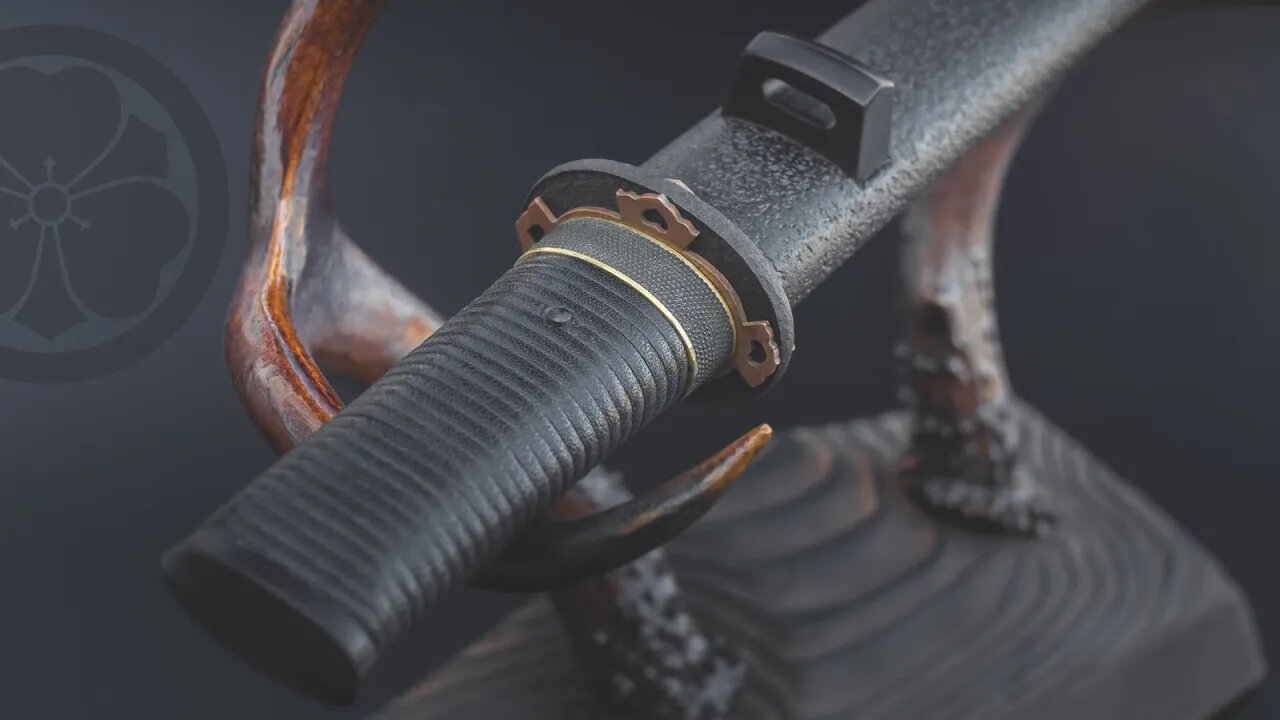Premium Only Content

SOTW #19 - Assembling the Inome Tanto
Making-of and photos here: http://islandblacksmith.ca/2019/07/inome-tanto/
The inome (pronounced “ee-no-may”, 猪の目, eye of the boar) name comes from the pierced heart-shape designs on the decorative o-seppa (washers) on either side of the tsuba (handguard). This lovely motif is ubiquitous in Japan, seen often in architecture, furniture, and sword mountings. In this context, the inome symbol conveys the idea of the always forward-moving wild boar of Japan’s forests and mountains, never giving up or retreating.
This tanto was forged from an antique horse-drawn carriage spring in 2016, was used at several demos as an example of the forged surface as it comes out of the fire, made a cameo in a short film in 2017 as one of the filing stages, was finished with geometry inspired by a visit to Japan in 2018, and is the first of my blades to incorporate antique sword parts in its mounting (there are 4, the rest is newly crafted for this piece).
The blade began as a reclaimed carriage spring and was hand forged in a charcoal fire, smoothed with files and a sen scraper, differentially hardened using traditional water quench yaki-ire, and polished by hand with natural Japanese water stones.
This tanto consists of ten separate components that began as twenty-two individual pieces, crafted and finished entirely with hand tools and traditional techniques.
Materials for the chisagatana style koshirae mounting include Japanese hounoki wood for the handle and scabbard, copper bus bar for the habaki, reclaimed brass doorplate for a seppa, buffalo horn for the mekugi and kurikata, and an iron spike salvaged from thirty feet under the Pacific for the tsuba. The centerpiece of the mounting comes from an outdoor antique market in Kyoto, a gold-accented Edo-era fuchi made from nanako-ji (魚子地, fish roe) textured shakudo (a traditional alloy of gold, silver, and copper). The tsuba sits between two Showa-era zouheitou (officer’s sword) o-seppa with pierced inome (猪の目, eye of the boar) motifs. The saya is finished in black sabi-nuri (rust texture) style ishime-ji (stone surface) made from natural source urushi lacquer and ground tea leaves, and the koiguchi band is also antique.
Blade has a hira-zukuri profile, suguha hamon with artifact on the omote, an iori mune, and an ubuha (unsharpened portion near the hamachi). The blade is 8.75″ long, overall length is just under 13.5″, and the overall length of the koshirae is just over 15″.
Specifications
長さ/刃長 Nagasa: 7 sun 3 bu 5 rin (222mm)
元幅 Motohaba: 9 bu (27mm)
重ね/元重 Motokasane: 2 bu 3 rin (7mm)
反り Sori: uchizori
中心/茎 Nakago: 3 sun 6 bu (109mm)
柄長 Tsuka: 3 sun 2 bu 5 rin (93mm)
拵全長 Koshirae: 12 sun 6 bu (382mm)
形 Katachi: hira-zukuri, iori-mune
刃文 Hamon: suguha, with ubuha
帽子/鋩子 Boshi: ko-maru
中心/茎 Nakago: futsu, kuri-jiri, one mekugi-ana, signed near the tip
銘 Mei: hot stamped katabami-ken kamon
拵 Koshirae: chisagatana, issaku (with the addition of four antique parts)
Material: Reclaimed carriage spring steel, Edo-period gold and shakudo nanako fuchi, antique brass koiguchi and Showa-era zouheitou o-seppa, ocean-salvaged iron spike, copper bus bar, brass doorplate, buffalo horn, Hounoki, leather, natural urushi and tea leaves, antique silk cord
-
 6:48:50
6:48:50
Akademiks
8 hours agoKendrick Lamar and SZA disses Drake and BIG AK? HOLD UP! Diddy, Durk, JayZ update. Travis Hunter RUN
99.5K5 -
 11:45:14
11:45:14
Right Side Broadcasting Network
9 days agoLIVE REPLAY: TPUSA's America Fest Conference: Day Three - 12/21/24
255K26 -
 12:19
12:19
Tundra Tactical
8 hours ago $7.09 earnedDaniel Penny Beats Charges in NYC Subway Killing
30.8K5 -
 29:53
29:53
MYLUNCHBREAK CHANNEL PAGE
1 day agoUnder The Necropolis - Pt 1
88.2K43 -
 2:00:10
2:00:10
Bare Knuckle Fighting Championship
3 days agoCountdown to BKFC on DAZN HOLLYWOOD & FREE LIVE FIGHTS!
42.6K3 -
 2:53:01
2:53:01
Jewels Jones Live ®
1 day agoA MAGA-NIFICENT YEAR | A Political Rendezvous - Ep. 103
100K23 -
 29:54
29:54
Michael Franzese
11 hours agoCan Trump accomplish everything he promised? Piers Morgan Article Breakdown
104K49 -
 2:08:19
2:08:19
Tactical Advisor
15 hours agoThe Vault Room Podcast 006 | Farwell 2024 New Plans for 2025
178K11 -
 34:12
34:12
inspirePlay
1 day ago $5.45 earned🏆 The Grid Championship 2024 – Cass Meyer vs. Kelly Rudney | Epic Battle for Long Drive Glory!
80.3K8 -
 17:50
17:50
BlackDiamondGunsandGear
13 hours ago $2.61 earnedTeach Me How to Build an AR-15
54.9K6